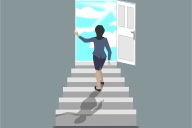You have /5 articles left.
Sign up for a free account or log in.

Istockphoto.com/sorbetto
We can probably agree that we live in an angry society. We encounter anger seeping out all over -- in politics, religion, families, the media and sports -- and certainly the educational arena is no exception. Other people’s anger creates varying responses in us. It may inhibit, frighten, stall and silence; alternatively, it may propel us to action. And it usually evokes a reaction or plan to try to manage it.
In this article, I will explore the ways in which anger and rage are tools in educating for critical consciousness, particularly in classrooms where special attention is devoted to the study of social inequalities and other charged topics.
What I have come to call creative pedagogical rage is what happens when complex emotions like anger and rage are successfully navigated and rechanneled through productive, transformative and positive processes and outcomes. Teaching with and for rage means embracing the ways that rage is a logical and legitimate response to felt injustices and then drawing on rage as a sort of compass, energy, life force and wellspring of creativity. Compassionate mentoring plays an important role in guiding students toward consciousness about rage, sustaining the focus on rage and dealing with the emotional fallout from it.
One of the greatest compliments I have received from students over the years is that, in my classroom, they discovered a place where they could disagree intensely yet respectfully about highly controversial and sensitive topics without it deteriorating into a full-blown argument -- and that having that opportunity paved the way to thinking about making personal and social change. Students tell me, for example, “These things that I once thought were ‘normal’ or ‘just the way the world was,’ I am now realizing are not the way things should be, and that I do have a right and responsibility to do something about them.”
Growing up amid verbal and emotional abuse and threats, and then going on to work for many years with abusers and survivors of domestic violence, has informed and shaped my stance on dealing with various manifestations of anger. And that made me, if not comfortable, at least much less anxious, around students’ anger. In fact, I credit batterers’ intervention work with giving me some of the language, tools and confidence to take into the classroom to unearth key dimensions of power related to structural inequalities. Certainly, most readers don’t share that work experience, so I will try to translate some of this knowledge in ways that can be useful in other faculty members’ classes.
One of the most crucial skills I honed when counseling abusers was how to engage in compassionate confrontation. That involved calling them on their abusive tactics and strategies, yet doing so in ways that not only resisted any collusion with their attitudes and behaviors but also gently, firmly and supportively encouraged them to look reflexively at what they had done.
Consequently, I feel less compelled to “manage” students’ anger or to employ techniques to pacify or nullify students’ emotions. Doing that seems analogous to me to boiling a large pot of pasta, continuing to let it boil, but nevertheless running over to the pot to put a lid on it to prevent the water from flowing all over the place. Why open up and teach the very topics that cut to the core of students’ fears, struggles, raging, identities, hopes and imaginations, only to run over to the students in discussion and extinguish the possibilities of dialogue on anger?
As co-explorers on a journey to uncover structural inequalities and injustices permeating social life and cultural practices, my students and I use the compass of rage to meander and navigate through the uncharted territory of our emotional responses to these deeply embedded social conditions. The compass of rage provides us with a way to imagine, map out for ourselves and express our longings for a vastly different sense of self and relationship to the world.
By offering students the possibility to work with rage, we provide them the opportunity to express what might move them. I often find myself asking students to consider what prompts people to make things change. I want to know what students are most hopeful about in the larger world and what they most fear. To understand my students’ rage or possibility for coming to consciousness around rage, I have to make a commitment to be with my students as they touch places of personal fear and anguish -- some for the very first time.
Rage can emerge from either uncovering and exposing structural inequalities or, as is the case of many students, simply revisiting the rage that has haunted them before as a result of directly experiencing such inequalities. Sometimes this is related to lived experiences of domestic violence and homicide, incest, poverty, homelessness, hunger, and racism. Observing the reality and magnitude of how their own seemingly personal and private experiences fit into a larger picture is indeed powerful. Significantly, for students experiencing debilitating mental health issues who have carried out angry, hidden and often dangerous protests on their bodies through self-harm like cutting, eating disorders or suicide attempts, it is often meaningful and even life changing when they start to conceptualize those behaviors as coping mechanisms for dealing with social conditions worth raging about.
Rage, then, is the predictable, desirable and courageous response to unpredictable, undesirable and outrageous social conditions and structural inequalities. I see rage as a dynamic, ambivalent and contradictory phenomenon -- as emotion and experience that is so dense, thick and intense that it has the potential to move a person out of complacency, out of confinement and most certainly out of comfort.
Transforming and Rechanneling
In my classes, I attempt to create a dialogue that fosters a fundamental paradigmatic shift in the way in which rage is internalized, used and perceived. Through facilitation of discussion, extensive commenting on students’ written work and individual appointments, I encourage students to draw out the interactional quality of their own individual and collective feeling states related to the concepts and theories emerging in a given course. The beauty of this method is that it is the students who must do the work of juggling their own feeling states, which are often vacillating wildly between their socialized loyalty to a culture that is often sexist, racist, homophobic or classist and their newfound experience in the classroom. In fact, the classroom, at its best, serves as a space to at least think about, if not actively participate in, a process of resocialization in the culture.
I assign readings that encourage students to get grounded in the rage of other great thinkers and writers. In turn, students see how writers write through, about and with rage, and then use such rage to generate a sense of meaning, a way of knowing and a place of being in the world. Rage, and the theory it generates, then, becomes a way of creatively rechanneling emotion, moving from silence to speech and resisting structures of domination. Thus, when students begin to come face-to-face with their own rage, its disquieting effects and life-altering possibilities, they begin to recognize rage’s potential for transforming long-held and long-felt fear and invisibility.
Rage is a cornerstone from which a new self-concept can be carved and redesigned. I have made class assignments that highlight social action and social justice so as to stimulate students’ questioning as they strive to make sense of the relationships between fear, rage and action. I have assigned projects that include, but are not limited to conducting interviews with activists, conducting interviews with people with a very different lived experience, going to a community organization to volunteer and reflect on the experience, attending campus or community events, and constructing a journal to record observations of gender, race and bodies in everyday life.
In addition, I not only permit but also encourage students to write papers and construct projects in ways that maximize and synthesize their other talents and interests such as poetry, art, photography, music, filmmaking and so on. I find that it is often through these more alternative projects that students work through their rage in ways that reveal strength and vulnerability in their expression and that assist them in discovering and recovering their own voice. Students’ corporeal and visceral reactions to learning about rage reflect bold, new, refreshing engagement with their bodies and newfound sense of voice.
For example, one student, an art major, created two pieces for her art portfolio that actively drew upon themes explored in our Sociology of Gender course. In one piece, she interrogated an icon of popular culture: Barbie. She made a book that told a story of Barbie as the victim of domestic violence, taking photographs of Barbie and Ken dolls and manipulating them into disturbing positions of domination and submission so as to capture the dynamics of power, control, fear and vulnerability. She bound the book in hot-pink terry cloth, replicating the color of Barbie paraphernalia. Made to resemble a wedding album and call into question appearances versus reality, she questioned skewed assumptions about race and class as they pertain to domestic violence.
In the second piece, she took two glass mason jars and filled them with symbols of sex and gender. One jar represented hegemonic notions of womanhood and the other those of manhood. She stuffed the jar representing womanhood full of items such as lipstick, pantyhose and a tampon. In the jar representing manhood, she simply and plainly included a sheet of white paper designed to look like a certificate and titled it “certificate of entitlement.”
My student illuminated her rage at the differential pressures, burdens, constraints, rewards and freedoms based on the social significance of gender. Most noteworthy is that her learning about rage transcended my classroom, and she extended it to and infused it in her projects for other classes in tangible and meaningful ways.
Helping students develop and strengthen their emotional skills for moving about in what is often a tense, troubled and angry world involves thinking about how we deal with anger and rage in our classrooms. It also demands that we gently and firmly make room and hold space for complex emotions, and then compassionately support students as they discuss, negotiate, write and redirect those emotions in positive ways.








